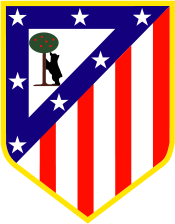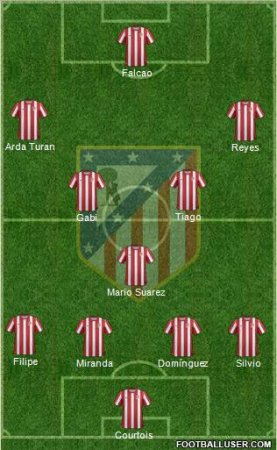Europa League Focus: Atlético Madrid
Publié le 27 September 2011 à 14h40 byEuropa League, Atlético Madrid - Stade Rennais, Thursday 18:00 CET. For its second game in Europa League’s group phase, Rennes will be host to the Atlético Madrid, winner of the competition in 2010. Gary Dunn, founder and webmaster of Atlético Madrid fan site madridatleticos.com, introduces the next opponent of the « Rouge et Noir ».
History
The Club Atlético de Madrid, S.A.D, best known as the Atlético Madrid, is the second club of the Spanish capital, and the third most successful club in the history of Spanish football, behind the giants of FC Barcelona and Real Madrid.
Founded in 1903 as the Athletic Club de Madrid by three Basque students installed in Madrid and willing to make it a branch of their favourite club, the Athletic Bilbao. Soon, the Athletic was joined by dissident members of the Real Madrid, and the club started growing, wearing the white and blue strips of Bilbao.
In 1911, the club changed colours and adopted the red and white shirt which is still worn today. There are various versions on how the club decided this change, but the Atlético Madrid had found its historical colours, and soon its nickname, the “Colchoneros” (The Mattress Makers) after the red and white stripes, common to the club’s colours and the fabric used for most of the mattresses at the time.
Three time winner in the Campeonato del Centro (The regional league of Spain’s central regions) in the 1920’s, runner-up in the Copa del Rey in 1921 and 1926, against the Athletic Bilbalo, the Athletic Club de Madrid was logically invited to join the first Spanish professional league, the Primera Division, for the inaugural season in 1928.
With a few seasons dotted with promotions and relegations, the club now known as Athletic Aviación de Madrid won its first La Liga title in 1940, repeating its success one year later in the stride of Ricardo Zamora and German Gomez, respectively the manager and captain, and both iconic characters of the club.
Having become the Club Atlético de Madrid in 1947, the Rojiblancos would then know their Golden Age, winning two more Liga titles in 1950 and 1951 under the management of Helenio Herrerra. In the shadow of the Real and FC Barcelona after the departure of Herrera in 1953, the Atlético remained the third most important club in the country and profited of Real Madrid’s European Cup success to also qualify for the continental competition and reach the semi-finals in 1958, only losing to the Real of Kopa and Di Stefano on the third and final game.
The Atlético would soon obtain its revenge though, since the second Madrid team was the only threat to the total domination of the « Casa Blanca » during the 1960s and 1970s, winning four La Liga titles and finishing second in three occasions, and also earning three Copa del Rey trophies and the European Cup Winners’ Cup in 1962.
A runner-up in the 1974 European Champions’ Cup (defeated by Bayern, 4-0), the Atlético remained a force to reckon with in Spain but slid back in the shadow of the country’s twop giants, still winning a Copa del Rey in 1976 and another Liga title in 1977 before reaching another European Cup Winners’ Cup final, lost against the Dynamo Kiev in 1986 (3-0).
In 1987, Jesús Gil arrived at the head of the Madrid club with the ambition to bring the Rojiblancos back to the top of Spanish football, and the massive moves made by the club’s new president on the transfer market allowed the club to have a taste of its glorious past, winning to more Copa del Rey and managing the League/Cup double in 1996. However, Gil’s shambolic management and his involvement in a corruption scandal harmed the club in the following years, and in 2000, the Atlético was relegated to the Segunda Division.
Back in Liga two years later, the Atlético rebuilt itself patiently with the help of one of its iconic managers, Luis Aragones, and the arrival of a new generation of talented young players led by Fernando Torres. Since then, pulled forward by players such as Diego Forlan, Sergio « Kun » Agüero and now Radamel Falcao, the Atlético Madrid is getting closer to its glorious past, acting as a serious outsider in the Liga behind the untouchable FC Barcelona and Real Madrid, and dreaded on the European Stage, as illustrated by their victory in the 2010 Europa League.
Context and Tactics
It has been all change at Atlético over the summer. Previous coach Quique Sanchez Flores was replaced by Gregorio Manzano. Flores failed to fix many of the on field problems at the club, although the Europa League success in 2010 masked many of those failures.
Manzano is currently enjoying his second stint at the club having previously been at the club during the 2003-2004 season. He was not a popular appointment and some were worried about what style of football he would bring. The only thing in his favour was that he is famous for helping underperforming players to rise to the occasion.
With the departures of Kun Agüero and David De Gea most were expecting a relegation fight for the season. But some shrewd signings have seen the clubs fans looking upwards.
Manzano prefers a 4-3-3 attacking style. He likes his team to bring the ball out from the defence on the ground and to keep possession. The team are instructed to win and crowd the ball when possession is lost. So far the new style has won over Atlético fans but it is still early days. This weekend’s match against Barcelona was an eye opener for fans and showed how far the club still has to go.
For the first time in years the club has a squad which allows them to rest, rotate or even drop key players. Considering that most of Atléticos transfer dealings were done at the end of the window it is fair to say that the players are still adapting to the new style. Also the perfect starting XI is not clear so Manzano has rotated quite a lot in the first few games. But even with the rotation system the style of play is the same with Manzano quoted as saying that the players will adapt to the system and not vice versa.
The wing backs pushing up and linking with the midfield have proven successful. With the aerial presence of Radamel Falcao there is an emphasis on crossing the ball. But Atlético are more than just crosses. The midfield open and crave out space slipping the ball into the front men to create goal scoring opportunities.
What has been Atlético’s Achilles heel in recent years, the defence, has been shored up too but still at times can look shaky when high balls come into the area. Some will point to the trashing by Barcelona but one must remember Barca have done it to the big guns too, just ask Jose Mourinho.
Line by Line
Goalkeepers: It is almost certain that Thibaut Courtois will play in goal. The young Belgian was tipped as a successor for David De Gea but the club lost out to Chelsea but the London club sent him on loan to Atlético. Has enjoyed an excellent start to the season and has won over Atlético fans that are hopeful he may be persuaded to stay beyond his loan deal. For back up there is Joel Robles who many considered as a direct replacement for De Gea but the club didn’t. Another possible inclusion could be the injury hampered Sergio Asenjo. Asenjo was seen as the ‘New Casillas’ but poor form and career threatening injuries have seen him just regain fitness and a place on the bench is the most he will hope for.
Defence: For the past few years this has been Atléticos Achilles heel. Things looked to be on the up when before this weekend Atlético had the best defence in La Liga. That was before they played Barca! Why Manzano changed a defence that had kept 3 consecutive clean sheets is still baffling. Right back Silvio has been a revelation since he signed but has had a few niggling injuries. Should he fail to be fit he will be replaced by Colombian international Luis Perea. Perea can also slot into the centre back role too. While being a loyal servant Perea has been responsible for some infamous errors at the back.
Alvaro Domínguez has had a great start to the season and earned himself a call up to the Spanish National team. He is currently Atlético’s strongest centre back. Miranda has been thrown into the deep end at Atlético and has not been welcomed by all the faithful. Diego Godín has been left on the side-lines in recent games but started against Barcelona but did very little to help his cause with a poor performance. So Miranda will be a favourite to start.
At left back Filipe who was rested against Barcelona should be recalled to replace Antonio Lopez who failed to perform this weekend. Antonio Lopez is club captain but is not a regular starter.
Midfield and Attack: Atlético are spoiled for choice in this department. The 4-3-3 system sees Atlético playing with one striker upfront with 2 attacking midfielders either side and 3 midfielders playing behind them.
Mario Suarez is the anchor in the midfield and if Manzano plays his strongest team he will be partnered by Gabi and possibly Tiago. Other candidates to play there are Koke and Assuncao.
Up front Jose Antonio Reyes should play on the right side of the central striker and Arda Turan on the left. Arda Turan has enjoyed a bright start to his Atlético career and while he may be ignored when it comes to the headlines, Atlético fans know how valuable he is. Brazilian playmaker Diego played this weekend after coming back from injury but may be left on the bench for this game. Other possible candidates for the midfield are young Argentine Salvio and Juanfran who if not in the team should at least find themselves on the bench. Forward Adrían has played as an attacking midfielder in previous Europa League games with success.
Adrían won the golden boot for Spain in the Under 21 European Championships this summer. He provided some essential assists in the qualifying rounds and could be used again to break down defences. But more than likely he will find himself on the bench. Radamel Falcao will start up front.
The striker has had some big shoes to fill with the departures of Kun Agüero and Diego Forlán and has had some impressive performances in his short time at Atlético. He is more than an aerial threat and Rennes will need to keep a close eye on him.
A player to watch: Radamel Falcao
Do I need to explain why? The tiger ended last season as the top scorer in the Europa League with 17 goals surpassing Jürgen Klinsmann’s previous record of 15. He added the Portuguese League and Cup to his Europa League success. He became a target for many top clubs but Atlético got their act together and signed the free scoring Colombian. His aerial prowess is well known but he is more than that. Against Sporting Gijon he received the ball, controlled it, craved out space and slotted the ball home. He has already opened his account in the Europa League by scoring against Celtic. Rennes will need to be careful because when the tiger is in box, he is lethal.
Thanks to Gary Nunn (http://www.madridatleticos.com/)
Photos: telegraph.co.uk, Wikipedia, Sergiolewin


